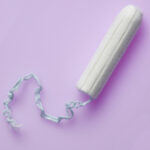 If you can’t remember if you removed a tampon, take the time to check before you insert another one. First, wash your hands with soap and water. Check your fingernails to make sure that you don’t have sharp nails. Then get into the position you would normally be in when you place a tampon in your vagina (sitting on the toilet, squatting down or standing with one foot on the toilet seat). Next, gently insert your index (pointer) finger into your vagina and try to feel for the tampon or string (if the product you use has one) move your finger back and forth a couple of times to see if you can feel the tampon. If you feel it, gently pull it out.
If you can’t remember if you removed a tampon, take the time to check before you insert another one. First, wash your hands with soap and water. Check your fingernails to make sure that you don’t have sharp nails. Then get into the position you would normally be in when you place a tampon in your vagina (sitting on the toilet, squatting down or standing with one foot on the toilet seat). Next, gently insert your index (pointer) finger into your vagina and try to feel for the tampon or string (if the product you use has one) move your finger back and forth a couple of times to see if you can feel the tampon. If you feel it, gently pull it out.
If you can feel it but are unable to pull it out, you could try to bear down (as if you were having a bowel movement). If you can’t reach the tampon, see your health care provider and have it removed as soon as possible.
When a tampon is left inside your vagina for too long, it creates a perfect environment for different types of bacteria, including Staphylococcus aureus, to grow. If you have left a tampon in, you may notice an unpleasant odor and/or discharge. The sooner the tampon is removed, the better!
Our health guides are developed through a systematic, rigorous process to ensure accuracy, reliability, and trustworthiness. Written and reviewed by experienced healthcare clinicians from Boston Children's Hospital, a Harvard Medical School teaching hospital and consistently ranked as a top hospital by Newsweek and U.S. News & World Report, these guides combine clinical expertise, specialized knowledge, and evidence-based medicine. We also incorporate research and best practices from authoritative sources such as the CDC, NIH, PubMed, top medical journals, and UpToDate.com. Clinical specialists and subject matter experts review and edit each guide, reinforcing our commitment to high-quality, factual, scientifically accurate health information for young people.